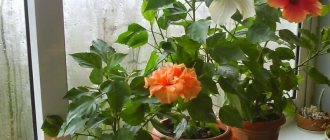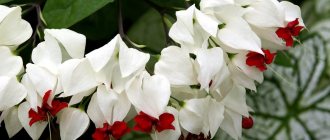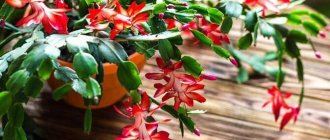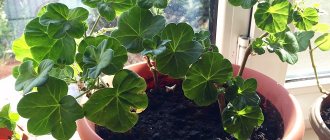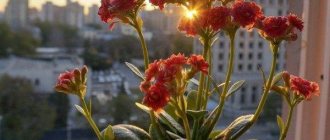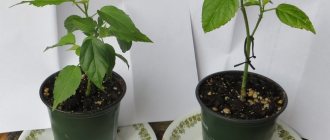Chinese rose (or hibiscus, as well as Indian or Tea rose) is a species of plant of the genus Rosehip, family Rosaceae. This flower comes from China. It is not found in the wild, but is very popular in indoor floriculture - tea rose buds are often used as tea leaves, which are used to make aromatic, invigorating tea.
While waiting for flowers, novice gardeners unknowingly pamper the plant, trying to create the most comfortable conditions for it: they fertilize it abundantly, place it in the sun, and provide regular and frequent watering. This is why many are perplexed when a rose does not want to bloom, despite all efforts.
Chinese rose
Most often, the reason for this is ignorance of the features of caring for Chinese roses at home.
About caring for Chinese roses at home
When caring for a plant in a house or apartment, you should pay attention to the following conditions for keeping the flower:
- frequency of irrigation and water quality;
- degree of illumination;
- regularity of feeding;
- need for pruning;
- temperature regime;
- location of the plant indoors;
- soil type.
Features of watering
It is necessary to water the Chinese rose once every 3-4 days, and the water for watering should not be cold. The optimal temperature of irrigation water is about 30 °C. The rose can also be sprayed and wiped with leaves of the plant, especially in hot weather. To increase air humidity, small containers of water are placed next to the rose. In conditions of high humidity, it is recommended to ventilate the room in which the flower is located more often.
Chinese rose
In winter, moisture stagnation as a result of frequent watering is especially dangerous. In hot weather, on the contrary, it is better not to spare water, but the next watering is carried out only when the top layer of soil is completely dry. In addition, the water used for irrigation must be soft.
Important! You can determine the quality of water by boiling - a film appears on the surface of hard water.
Illumination level
Full development of a flower is impossible without observing lighting conditions. Hibiscus grows well in partial shade, but will not set buds. On the other hand, direct sunlight causes burns to rose leaves. It is best to position the plant so that it is in diffused lighting conditions.
How and what to feed
For proper development of the plant, moderate feeding is necessary. Excessive enrichment or poor soil is equally harmful to the Chinese rose.
Specialized complex mineral fertilizers
During the period of active growth (March-September), flowers are fed every week. During the rest period (October-February), the frequency of feeding is reduced to once a month. It is recommended to use specialized complex mineral fertilizers as top dressing.
Important! Enriching the soil with nitrogen only stimulates leaf growth, while phosphate fertilizing promotes abundant flowering.
Trimming
You can “make” a Chinese rose bloom using the pruning procedure. Hibiscus flowers form only on young shoots, so pruning the plant helps the buds form.
Pruning is done before the hibiscus awakens.
Temperature
In the winter months, it is necessary to provide conditions for the rose to go into hibernation, which is impossible at temperatures above +13˚C. In addition, at this time it is advisable not to feed the plant and keep watering to a minimum.
Sudden changes in dormant temperature can also affect a flower's ability to set buds.
Rearrangement
Hibiscus does not respond well to frequent rearrangements. Changes in microclimate cause stress to the plant, which may begin to wither, and minor mechanical damage leads to the fact that the rose begins to shed leaves and flowers. Even a slight sway of the branches is enough.
Hibiscus does not respond well to frequent rearrangements.
Soil type
Hibiscus is a rather capricious plant, demanding on the type of soil. It grows well only in fertile, loose soil mixtures with moderate acidity. To improve the composition of the soil, you can fertilize it with coal chips or humus.
Description
Including about two hundred species, the genus of hibiscus, wild and “domesticated”, is quite extensive and is represented by various plants - trees, shrubs, perennial and annual herbs. The basis of the genus is still made up of woody shrubs - decorative, flowering and striking with solemnity and splendor. This is exactly how Russian flower growers know this plant, calling it Chinese rose and successfully growing it at home. In nature, hibiscus grows in the humid tropics and subtropics, often forming lush flowering thickets. The predilection for the abundance of moisture in these plants has given rise to another unofficial name that emphasizes their characteristics - marsh mallow.
Large, exquisite flowers with bright, graceful corollas that bloom at the ends of the shoots are very beautiful. They made the plant a national symbol of Hawaii and a particularly revered crop in many countries in East Asia and South America. Dark green leaves of varying degrees of incision, dense and petiolate, support the decorative appearance of the plant. The fruit is a capsule, split into several valves, containing many seeds, smooth or slightly pubescent.
Hibiscus, the photo of which is presented in the publication, is not only decorative, but also useful. Young leaves and stems of many plant species are eaten, and seeds, fruits and roots serve as raw materials in pharmacology, medicine, perfumery. We will learn the features of growing crops in the home and garden.
Why does the Chinese rose not bloom at home?
Chinese rose: home care
There are many reasons why the Chinese rose does not bloom at home. Balance is the most important condition for the proper development of a flower. Therefore, it is customary to highlight the following reasons why a rose stops blooming:
- excess or lack of sunlight;
- frequent rearrangement of plants from place to place;
- excessive enrichment of the soil with fertilizers or its depletion;
- lack of timely pruning;
- sudden changes in temperature;
- too rare or, conversely, too frequent watering.
Note! In addition, it is especially worth highlighting the damage to roses by fungal diseases and pests.
Awakening the "sleeping beauty": don't miss the moment
Hibiscus wakes up at the end of winter; now it needs sunbathing, good nutrition, abundant watering and warmth. It is very important not to miss this transitional moment and to provide the indoor plant with the necessary conditions in a timely manner. You can notice that the rose has woken up by the growth of young leaves. Do not wait for the buds to appear, because if you are late in moving the flowerpot to a warm, bright place, the hibiscus will not bloom soon - it will shed the first emerging flowers. Reasons: stress, changes in microclimate and mechanical damage (tender buds fall off even from barely perceptible swaying of the branches).
What can I do to make hibiscus bloom more abundantly and have a beautiful crown shape? Carefully trim off old branches before it wakes up. The tree will quickly sprout new shoots and become more lush and attractive. In addition, double roses appear only on young branches. If you feel sorry for cutting your pet’s hair, don’t be surprised why it doesn’t bloom.
Methods of controlling infections and pests
Of particular danger to this species are:
- aphids are a rapidly multiplying harmful insect that settles on roses on the underside of the leaves;
- spider mite is a small insect of light green color with black spots;
- powdery mildew or downy mildew - the first signs of the disease are brown spots on the leaves of hibiscus, which lead to the leaves beginning to fall off;
- spotting - manifests itself in the form of rotting spots with an oily border.
Chinese rose (flower of death): why you can’t keep it in the house
In the case of insects, it will be sufficient to treat the plant with any insecticide or acaricide. When there are too many pests, Actellik is used. Dosage: 15 drops of product per 1 liter of water. Korbofos and Metathion are also suitable. A weak solution of kerosene is no less effective.
Drugs such as Acrex, Omite, Actofit or Isofen can help in the fight against spider mites.
Important! The instructions for the drugs will say that they need to be used repeatedly. Why - newbies ask. The fact is that these chemicals only affect adults, without causing any harm to the eggs, so a one-time spraying will not give the desired result. To get rid of the pest, roses are sprayed about 5 times every 2-3 days.
If desired, chemicals can be replaced with a soap solution with pepper, which has a more gentle effect on the flower.
If spotting is detected, the rose is treated with Cumulus or Rovral. In case of chlorosis, hibiscus is sprayed with iron chelate and the flower is fed with organic matter.
How and when does hibiscus bloom?
A plant grown from seeds opens its first corollas 3-4 years after germination. The cuttings can produce buds not yet fully rooted - in water, perlite, or a peat-sand mixture. It cannot be allowed to bloom, otherwise it will take a long time to produce lower shoots and perhaps disappear.
With good care, Chinese rose blooms from spring to autumn, 8-10 months a year. If the maintenance is generally correct, but the owners do not take very good care of the plant, the bush, regardless of the season, continuously produces buds for 2-3 months. Then it gains strength and sometimes blooms again.
You can find statements that hibiscus is at its peak of decorative value from June or July to September. Indeed, in many homes culture blooms at this time, even with ideal care. The reason is that the owners do the pruning too late, when new leaves have already blossomed. This delays the formation of buds by 3 months.
Each whisk lasts from 1 to 3 days. The Chinese rose fades most quickly in the heat - the flower bloomed in the morning and wilted in the evening. The corollas of terry varieties are preserved for a long time or in cloudy, cool weather.
Prevention
Why doesn't the rose bloom?
It is always better to prevent a disease than to treat it. In most cases, problems associated with the fact that a rose does not want to bloom arise due to improper care and inattention, therefore timely and correct implementation of agricultural techniques is used as a disease prevention.
It is necessary to inspect the plant from time to time and remove leaves from the pot.
Since the main reason for the appearance of pests is increased dry air, prevention against insects involves moderate air humidification. The pot with the rose is placed on a small tray with a wet stone, and the hibiscus leaves are periodically sprayed with settled water. In addition, it is necessary to inspect the plant from time to time and remove leaves from the pot that have fallen. This will create unfavorable conditions for pests.
Diseases, on the contrary, are most often caused by high soil and air humidity. To reduce the risk of roses being damaged by fungal diseases, it is enough to maintain optimal air humidity in the room. Also, as a preventative measure, rose bushes can be sprayed with any brand of fungicide.
Sometimes attempts to provide maximum comfort to a plant can lead to inhibition of its development or even death. Too much care is just as harmful as too little care, so it is important to maintain a balance when caring for Chinese roses. Moderate feeding, rest in winter, timely pruning and protection from drafts - that’s all a flower needs for proper development and abundant flowering.
0 0 votes
Article rating
Lack of flowering of a garden plant
The lack of flowering can be observed not only in indoor, but also in garden hibiscus. As in the previous version, when we discussed indoor floriculture, the reason for the lack of flowering of a plant grown outdoors in the garden may be improper care. Most often, novice gardeners try to water the flower abundantly. However, according to the recommendations of gardeners with many years of experience, hibiscus does not like soil that is too wet during the growing season.
Another reason for the lack of amazingly beautiful buds is excess nitrogen in the soil. Don’t get too carried away with fertilizers; you need to feed the plants moderately and in a timely manner.
Also, do not forget that the lack of pinching and pruning of an ornamental bush can cause a flowering hibiscus to refuse to throw out new buds and eventually stop blooming altogether.
Various diseases and insects can interfere with the flowering of indoor or garden hibiscus. Among the diseases that are characteristic of ornamental crops of the Malvaceae family are root rot, fungal infections, as well as chlorosis of infectious and non-infectious types.
The most common pests include common aphids, scale insects and spider mites. What to do to make a sick hibiscus bloom? Fungicides will help protect the flower from fungal infections, and you can get rid of harmful insects using a regular soap solution or insecticides.
Wrong landing site
When cultivating roses in the cold Russian climate, the planting location . You should know that roses, these natives of the southern regions, are very sensitive to a lack of sunlight. They need at least 8 hours of full sun to fully develop and bloom. The degree of illumination determines the strength of growth, the number of flowers, and the health of the rose bush. Therefore, it should be planted in as open an area as possible. This is an indispensable condition! If you planted a rose in the shade of trees, fences or buildings, you can’t expect flowering, it won’t happen.
Incorrect pruning
The next possible reason for the lack of flowering is improper pruning . In spring, some groups of roses (scrubs, English roses, climbing roses) should never be heavily pruned. For them, only a sanitary and light shaping haircut is used, when the tops are shortened to a strong bud. This is done to stimulate branching.
You should not try to form a small bush rose from a tall scrub. By cutting its stems in half (as is sometimes recommended), you will significantly delay the flowering time, since the plant will take a long time to recover from this procedure, growing new shoots. But, interestingly, her growth pattern will remain the same, that is, all sacrifices will be in vain.
In summer, in order to force the rose to produce new flowering shoots, it is necessary to promptly remove wilted flowers . If you live in a country house, it is advisable to do this every day, going out into the garden with pruning shears. If you neglect this rule, you will not wait for re-blooming.
Faded buds are cut off immediately. Photo by the author
In addition, all the so-called “blind” shoots that have not produced buds must be shortened (certainly by a strong bud) by about half, thereby encouraging the rose to branch. This technique allows you to achieve flowering. But this is all provided that the plant is healthy and receives enough sunlight and nutrition.
One more nuance: if for some reason in the spring (you didn’t know, didn’t notice, or were simply lazy) you didn’t remove the thin and unproductive shoots growing inside the bush or close to the ground, which will never bloom, remove them in the summer. An important rule of English flower growers applies here: there should be no shoots thinner than an ordinary pencil on a rose bush. The rose, freed from them, will concentrate its forces on the flowering of the main ones.
Removed non-productive shoots. Photo by the author You can learn about all the intricacies of pruning roses of different types in the Pruning Academy of our website. Take a look at Lesson 7. Pruning roses.
Features of winter maintenance
To ensure a successful wintering for an exotic plant, you will have to make some efforts. Bushes with double flowers tolerate sub-zero temperatures best, which should be taken into account in advance. Frost is detrimental to hibiscus, so the plant is either transplanted into the basement or protected from the cold right outside. Each pruned bush is given its own shelter - a rigid frame covered with agrotex. This protective structure is effective in regions where the temperature does not drop below -15 degrees Celsius. When the ambient temperature is much lower, hibiscus requires more reliable insulation. The branches are tied and bent to the ground, wrapped in a bag. A kind of hut made of dense spruce branches is installed on top of the bush, reinforced with dense fabric or poles.
Guest from Asia
Hibiscus is a genus that includes 241 species of shrubs, trees and herbaceous plants. Many varieties are grown in ornamental gardening as garden and indoor flowers. In administrative buildings, hospitals, and private homes you can find Chinese hibiscus or Chinese rose.
Chinese rose is an evergreen ornamental plant from the Malvaceae family. It grows naturally in southern China and the Indochina Peninsula. The flower requires a warm climate, so in Russia it is grown only in greenhouses and indoors.
The plant is characterized as an evergreen shrub, has bright, shiny, ovoid foliage and large, rich red flowers. The buds bloom alternately from late spring and bloom until autumn.
Healing tea is brewed from Chinese rose petals. It has a large amount of vitamin C, so it helps with colds, and also has a calming effect on the human body.
According to reviews from flower growers, the shrub is undemanding to its owner. Simple living conditions and minimal care are necessary for the culture to grow and develop normally. But many lovers of indoor plants complain about the lack of long-awaited buds. If the hibiscus does not bloom, mistakes were made during cultivation. Both a lack and an excess of attention for a flower can affect its growing season.
How to stimulate a crop to bloom
The following factors directly stimulate flowering:
- pinching, pruning;
- phosphate fertilizers;
- dormant period in winter in a cool, dark place;
- watering twice with warm water during the flowering period;
- the pot is too tight for the root system;
- absence of drafts and temperature changes;
- spraying, air humidification;
- pest control.
The place where the hibiscus lives should be well lit and have a more or less stable temperature. Well-lit canopies and verandas are ideal for this; they protect the plant from excessively bright sun.
The best indoor varieties
Flower growers value hibiscus for its unpretentiousness, abundant flowering, and rapid growth. Over the years, the bush becomes spreading and presentable. Throughout the year it is decorated with dark green leaves with a jagged edge. The advantage of the plant is early flowering. Buds can appear even on newly rooted cuttings.
Oval leaves grow up to 15 cm in length, buds form on pedicels. Each flower lives no more than a day, but thanks to their abundance, the crown looks colorful throughout the season.
The best types for indoor growing:
- Chinese hibiscus is a species that includes about 500 varieties. For indoor growing, carmine red, Florida, Vero's Saree, and Terry rose are most often purchased. The plant grows successfully up to 25 years and tolerates pruning and light shading.
- Another species that grows successfully on windowsills is Syrian. Differs in slow growth, but significant life expectancy. For growing on a windowsill or on a veranda, choose Totus Albus and Monstrosus with snow-white petals, Pink Chiffon.
- Hybrid hibiscus has large buds of pale pink color. Popular varieties are Fireball, Old Yela, Russian Size, Ardens.
- Abutilone is a close relative of hibiscus. At home, mainly hybrid varieties are grown, which are characterized by more luxuriant and longer flowering. Abutilone buds can be white, yellow, or variegated. Outwardly, they resemble mallow flowers.
Reproduction
There are two main methods of reproduction:
- Seeds . Gardeners often do not use such planting material, since quite a lot of time passes from the moment of planting to the first flowering, which is not entirely convenient.
- Cuttings . After planting the cuttings, the plant blooms already in the first year of life, with the exception of the Syrian one. This was the main reason for the popularity of this particular method of growing hibiscus in personal plots.
The cutting must have at least two internodes. The cut is treated with a growth stimulator and the planting material is placed in a soil-peat mixture, creating greenhouse conditions. A month later, when the roots appear, the cuttings are transplanted from the greenhouse into pots filled with a mixture of leaves, peat, sand and soil, taken in equal proportions. Young shoots need some care. They definitely need to be pinched. Otherwise they will not form a bush. Transplantation directly into open ground is carried out after the cuttings acquire the semblance of a small bush.
